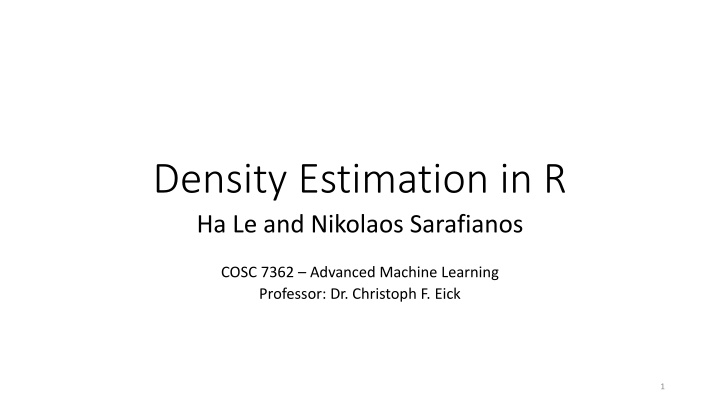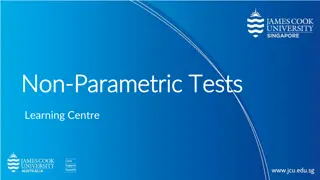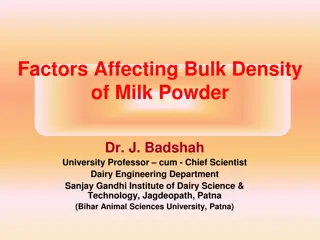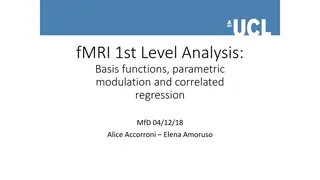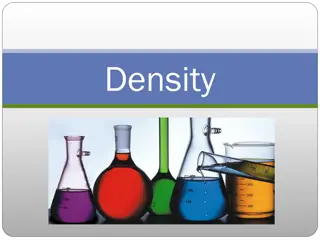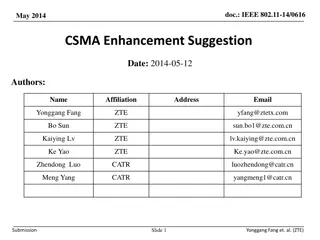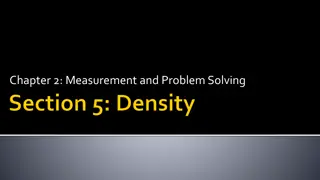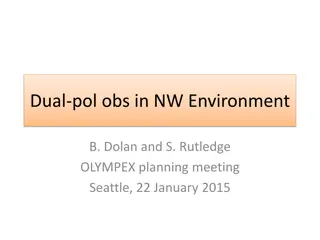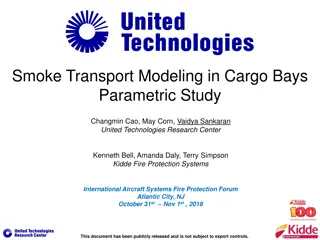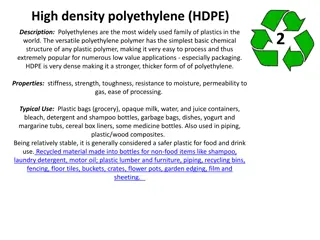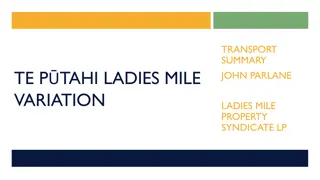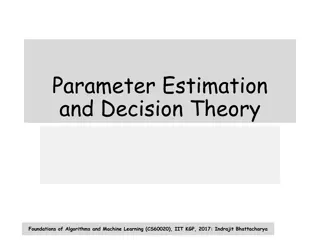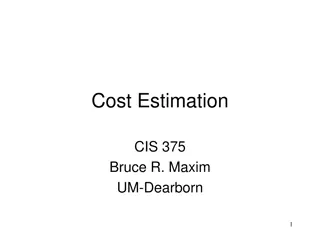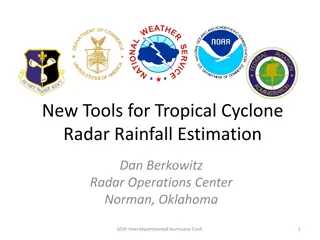Density Estimation in R: Parametric vs. Non-Parametric Methods
This content delves into the concepts of density estimation in R, comparing parametric methods where a specific form of the density function is assumed known, with non-parametric methods that require no assumption on the distribution's form. Explore topics like maximum likelihood estimation, Bayesian estimation, and fitting distributions to datasets using R.
Download Presentation

Please find below an Image/Link to download the presentation.
The content on the website is provided AS IS for your information and personal use only. It may not be sold, licensed, or shared on other websites without obtaining consent from the author.If you encounter any issues during the download, it is possible that the publisher has removed the file from their server.
You are allowed to download the files provided on this website for personal or commercial use, subject to the condition that they are used lawfully. All files are the property of their respective owners.
The content on the website is provided AS IS for your information and personal use only. It may not be sold, licensed, or shared on other websites without obtaining consent from the author.
E N D
Presentation Transcript
Density Estimation in R Ha Le and Nikolaos Sarafianos COSC 7362 Advanced Machine Learning Professor: Dr. Christoph F. Eick 1
Contents Introduction Dataset Parametric Methods Non-Parametric Methods Evaluation Conclusions Questions 2
Introduction Parametric Methods: A particular form of the density function (e.g. Gaussian) is assumed to be known and only the parameters (e.g. mean, covariance) need to be estimated. Non-parametric Methods: Adopt no assumption on the form of the distribution, however, a lot of examples are required. 3
Datasets Created a synthetic dataset containing 10000 samples that follow a randomly generated mixture of 2 Gaussians 4
Parametric Methods Maximal Likelihood estimation Bayesian estimation 5
Maximum Likelihood Estimation Statement of the Problem: Density function p with parameters is given and xt~p (X | ) Likelihood of given the sample X l ( |X) = p (X | ) = tp (xt| ) We look for that maximizes the likelihood of the sample ! L( |X) = log l ( |X) = tlog p (xt| ) Maximum likelihood estimator (MLE) *= argmax L( |X) 6
Maximum Likelihood Estimation (2) Advantages: 1. they become unbiased minimum variance estimators as the sample size increases 2. they have approximate normal distributions and approximate sample variances that can be calculated and used to generate confidence bounds 3. likelihood functions can be used to test hypotheses about models and parameters Disadvantages: 1. With small numbers of failures (less than 5, and sometimes less than 10 is small), MLE's can be heavily biased and the large sample optimality properties do not apply 2. Calculating MLE's often requires specialized software for solving complex non- linear equations. 7
Maximum Likelihood Estimation (3) Stats4 library Fitting a Normal Distribution to the Old Faithful eruption data(mu = 3.487, sd = 1.14 mu\sigma 0.25 0.5 1 2 4 0 67.1 (283) 1 85.5 (1008) 2 47.7 (422) 3 3.487 (1.139) 3.487 (1.139) 4 3.487 (1.139) 3.487 (1.139) 5 -41.7 (434) 10 -330 (1091.6) -196 (530) 148.8 (1127.74) 3.487 (1.139) 3.487 (1.139) 3.487 (1.139) 102 (588) 3.487 (1.139) 3.487 (1.139) 3.487 (1.139) 3.487 (1.139) 3.487 (1.139) 3.487 (1.139) 3.487 (1.139) 3.487 (1.139) 3.487 (1.139) 3.487 (1.139) 3.487 (1.139) 3.487 (1.139) 3.487 (1.139) 3.487 (1.139) 3.487 (1.139) 3.487 (1.139) 3.487 (1.139) -342 (2313) -42 (160) 3.487 (1.139) 8
Maximum Likelihood Estimation (4) Other libraries: Bbmle : has mle2() which offers essentially the same functionality but includes the option of not inverting the Hessian Matrix. 9
Bayesian estimation The Bayesian approach to parameter estimation works as follows: 1. Formulate our knowledge about a situation 1. Define a distribution model which expresses qualitative aspects of our knowledge about the situation. This model will have some unknown parameters, which will be dealt with as random variables 2. Specify a prior probability distribution which expresses our subjective beliefs and subjective uncertainty about the unknown parameters, before seeing the data. 2. Gather data 3. Obtain posterior knowledge that updates our beliefs 1. Compute posterior probability distribution which estimates the unknown parameters using the rules of probability and given the observed data, presenting us with updated beliefs. 10
Bayesian estimation (2) Available R packages MCMCpack is a software package designed to allow users to perform Bayesian inference via Markov chain Monte Carlo (MCMC). Bayesm package for Bayesian analysis of many models of interest to marketers. Contains a number of interesting datasets, including scanner panel data, key account level data, store level data and various types of survey data 11
Bayesian estimation (3) Credible intervals and point estimates for the parameters. Iterations = 1001:11000 Thinning interval = 1 Number of chains = 1 Sample size per chain = 10000 1. Empirical mean and standard deviation for each variable, plus standard error of the mean: Mean SD Naive SE Time-series SE (Intercept) 33.48 1.1593 0.011593 0.011593 x 10.73 0.3174 0.003174 0.003174 sigma2 35.24 3.0619 0.030619 0.031155 2. Quantiles for each variable: 2.5% 25% 50% 75% 97.5% (Intercept) 31.21 32.70 33.49 34.26 35.76 x 10.11 10.52 10.73 10.94 11.35 sigma2 29.72 33.10 35.07 37.22 41.68 12
Non-Parametric Methods Histograms The naive estimator The kernel estimator The nearest neighbor method Maximum penalized likelihood estimators 13
Histograms Given an origin x0 and a bin width h Bin of histogram: [x0+mh, x0+(m+1)h) The histogram: Drawback Sensitive to the choice of bin width h Number of bins grows exponentially with the dimension of data Discontinuity 1 nh ( ) ( ) f x = numberof X inthesamebinas x i 14
Histograms Packages graphics::hist 15
Histograms The optimal bin width is 0.3 16
The Nave Estimator 1 hn The na ve estimator: Drawback Sensitive to the choice of width h Discontinuity ( ) ( ) ( ) f x = + , numberof X fallingin x h x h i 2 17
The Nave Estimator Packages stats::density 18
The Nave Estimator The optimal bin width is 0.4 19
The kernel estimator 1 nh x X n Kernel estimator: K: a kernel function that satisfies: h: window width F is continuous and differentiable Drawback Sensitive to window width Add more noise to long-tailed distributions ( ) f x = i K h = 1 i = ( ) 1 K x dx 20
The kernel estimator (2) Using the density function and a synthetic dataset 21
The kernel estimator (3) Using the a triangular kernel and a different smoothing parameter 22
The kernel estimator (4) Using the a Gaussian kernel and a different smoothing parameter 23
The kernel estimator (5) Errors for the triangular and the Gaussian Kernels 24
The kth nearest neighbor method k ( ) f t The kth nearest neighbor density estimator: The heavy tails and the discontinuities in the derivative are clear = 2 ( ) nd t k 25
The kth nearest neighbor method Packages FNN::knn 26
The kth nearest neighbor method The optimal k is 650 27
Maximum penalized likelihood estimators ? The likelihood of a curve g as density: ? ? ?1, ,?? = ?=1 ?(??) 1 ? ?? ? the naive density estimate ? ??? = ?=1 ? ? quantifies the roughness of g log ? ?? ??(?) is the penalized log likelihood 28
Penalized Approaches R packages: gss uses a penalized likelihood technique for nonparametric density estimation 29
Penalized Approaches (2) Estimate probability densities using smoothing spline ANOVA models (Ssden function) 30
Additional R Packages for Non-Parametric methods General weight function estimators: Wle package http://www.dst.unive.it/rsr/BelVenTutorial.pdf Bounded domains and directional data: BelVen package http://www.dst.unive.it/rsr/BelVenTutorial.pdf 32
Evaluation Mean Square Error 2.00E-05 Method Error 1.80E-05 1.79E-05 Histogram with bw=0.3 1.60E-05 6.29E-06 Na ve Estimator with bw=0.4 1.40E-05 4.53E-06 Triangular Kernel with bw =0.3 1.20E-05 4.69E-06 Gaussian Kernel with bw=0.3 1.00E-05 1.47E-05 kth nearest neighbor with k=650 8.00E-06 3.798E-06 Penalized Approaches with a = 4 6.00E-06 4.00E-06 2.00E-06 0.00E+00 Histogram with bw=0.3 Na ve Triangular Kernel with bw =0.3 Gaussian Kernel with bw=0.3 Epanechnikov Kernel with bw=0.3 Cosine Kernel with bw=0.3 kth nearest neighbor with k=650 Penalized approaches with a = 4 Estimator with bw=0.4 33
Conclusions The initial mean and the sd affect the MLE performance Since our data are balanced, different kernels do not affect the error of the kernel estimation The knn estimator is slow and inaccurate, especially in a large dataset. The penalized approach which estimates the Probability Density Using Smoothing Splines is also slow but more accurate than the kernel 34
References [1] Silverman, Bernard W. Density estimation for statistics and data analysis. Vol. 26. CRC press, 1986. [2] Deng, Henry, and Hadley Wickham. "Density estimation in R." Electronic publication (2011). [3]http://homepages.inf.ed.ac.uk/rbf/CVonline/LOCAL_COPIES/AV0809 /eshky.pdf 35
Questions 36
